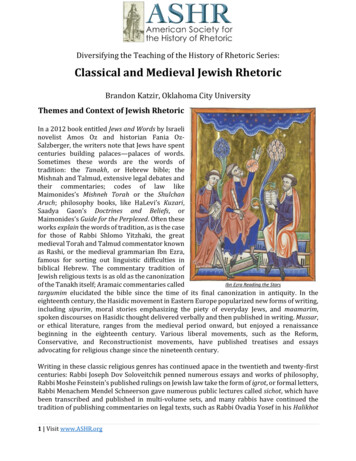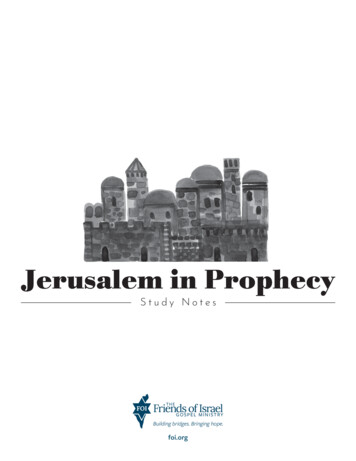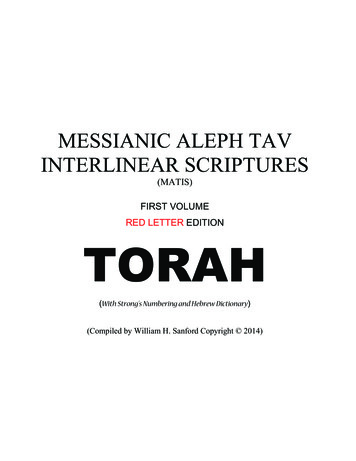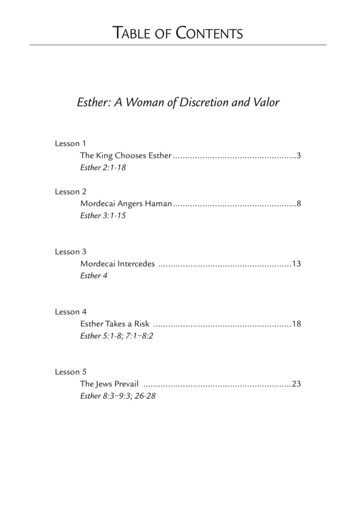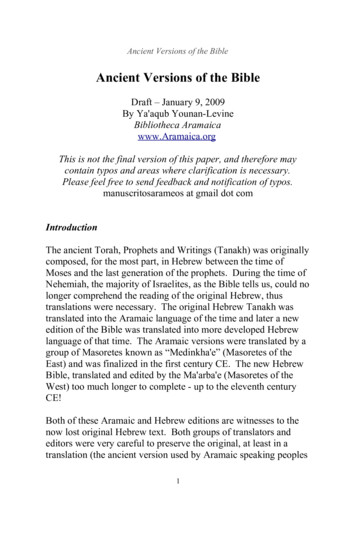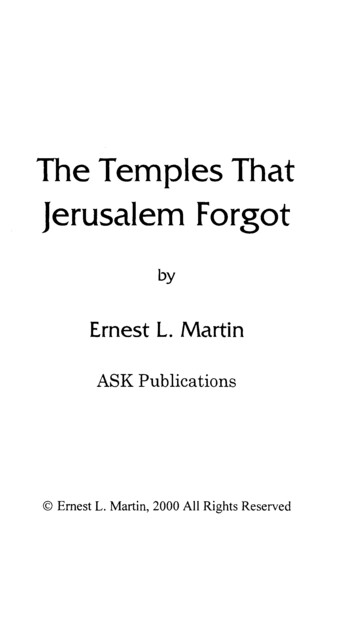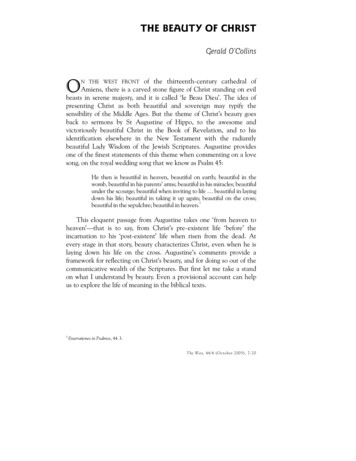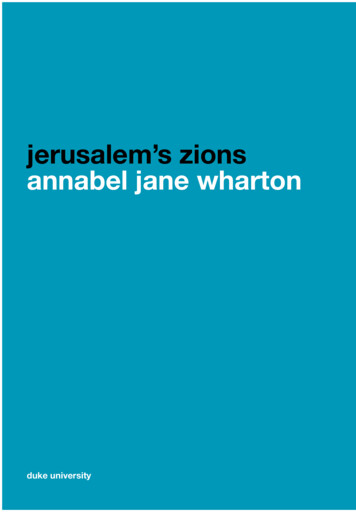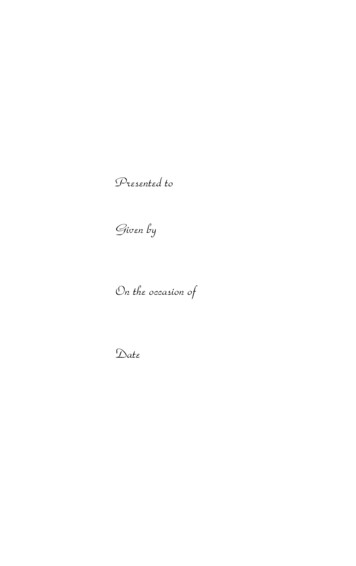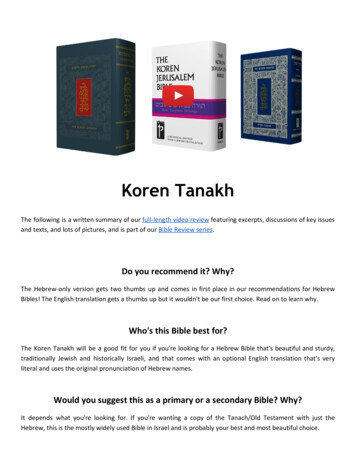
Transcription
Koren TanakhThe following is a written summary of our full-length video review featuring excerpts, discussions of key issuesand texts, and lots of pictures, and is part of our Bible Review series .Do you recommend it? Why?The Hebrew-only version gets two thumbs up and comes in first place in our recommendations for HebrewBibles! The English translation gets a thumbs up but it wouldn't be our first choice. Read on to learn why.Who's this Bible best for?The Koren Tanakh will be a good fit for you if you're looking for a Hebrew Bible that's beautiful and sturdy,traditionally Jewish and historically Israeli, and that comes with an optional English translation that's veryliteral and uses the original pronunciation of Hebrew names.Would you suggest this as a primary or a secondary Bible? Why?It depends what you're looking for. If you're wanting a copy of the Tanach/Old Testament with just theHebrew, this is the mostly widely used Bible in Israel and is probably your best and most beautiful choice.
If you want a Hebrew/English Bible to carry around and read from on a regular basis this couldwork, but be aware that the English translation isn't the smoothest read, and the book itself canbe a little clunky depending on which version you get. See the end of this review for a list offormats, and links to purchase.How's this version's relationship with the Jews and Judaism?The Koren Tanakh is hailed in the Introduction as "the first Jewish Bible in over 450 years". Not only was itproduced by religious Jewish editors, type designers, printers, binders, and translators, but it was developedwith a high degree of sensitivity to the Masoretic tradition, and was the first Jewish Bible to use the originalpronunciation of Hebrew names in the English text.The Koren Tanakh isn't only religiously Jewish, either. It's alsodistinctively Israeli. Produced by Israelis, published in the holy city ofJerusalem, given to every soldier upon their swearing in, and used in theoath of office taken by members of the Knesset, this Bible is a centralcharacter in the story of modern Israel. Upon its release in the 60sspeaker of the Knesset Kadish Luz declared, "From this day forth all ofIsrael’s presidents shall take their oaths of office upon this Bible. Wehave been governed by a Provisional State Council, a ProvisionalGovernment and even now sit in the temporary Knesset building. To date, Israeli presidents have been swornin using a temporary edition of the Bible. This occasion symbolizes our overcoming of foreign heritage andreturn to our origins." And David Ben Gurion himself simply exclaimed, "Israel is redeemed from shame!"Watch the video review for historic recommendations from famous Rabbis, a discussion of how it could bethat no Jewish Bibles were published for 450 years, pictures of Israeli postage stamps celebrating KorenPublishers, and pictures of Israeli soldiers being given a Bible and a machine gun for their swearing inceremony.Who's the publisher and when did it come out?To tell the story of Koren Publishers Jerusalem one must start with Eliyahu Koren, the artist who left biblicalfingerprints all over the story of modern Israel.Koren started out as Eliyahu Korngold, born in 1907 and raised in Nuremberg Germany. He was agifted artist from an early age, and completed a six-year graphic and applied arts course in onlythree years. In 1933 news reached the young Eliyahu that Bavarian Jews were being required tocarry special secret police travel permits to travel abroad. He later said, "I saw by this verdict
divestiture of the freedom of the Jewish individual, and decided to leave Germany at the earliest possiblehour." Korngold made aliyah, and arrived on the shores of what was then Palestine at the age of 26. Heworked as a graphic artist in Tel Aviv before serving as head of the graphics department of Keren Kayemet, theJewish National Fund, from 1936 to 1957. In 1950 he designed the Emblem of Jerusalem, which continues tobe used today.In the 1940s Korngold was approached by Judah Magnes, the president of the HebrewUniversity, about producing a Hebrew Bible. He chaired the university's Bible Committee forseveral years, but along with other scholars on the committee became dissatisfied with thedirection of the project. So in the late 50s he set out to do it himself. He created a new fontwhich he named the Koren Bible Type, developed a graphic layout, and gathered a team toproofread and correct a previous edition of the Hebrew text to ensure complete agreementwith Masoretic tradition. In 1961, at the age of 44, Korngold changed his last name to Korenand founded Koren Publishers Jerusalem. In 1962 the Koren edition of the Torah wasreleased during the patriotic holiday of Chanukah, with the complete Tanakh following twoyears later. And finally in 1967 Koren released its English translation of the Tanach, theKoren Jerusalem Bible.As a master typographer and graphic artist, Koren was a shining example of the power that artists have tocreate culture and steer society. In 1998 he was awarded the Jerusalem Prize, the city's most prestigiousaward. He died three years later at the age of 94, but the story of Koren Publisherscontinued. Under the leadership of Matthew Miller, who bought the company in 2007,Koren has continued to release significant works, including the colourful Steinsaltz editionof the Talmud and the Koren Sacks Siddur, which is the only Orthodox prayerbook thatincludes prayers for the state of Israel, its soldiers, and its national holidays. Of it Millersaid "In our hashkafa Zionism is important, the state of Israel is important, and engagingthe world is important."Truly, to tell the story of Koren - both the man and the company - is to tell the breathtaking story of modernIsrael. Watch the video review for dozens of vintage pictures of the Koren story and for a discussion of theIsraeli phenomenon of taking a Hebrew name.Who translated it and what's their story?The story of Harold Fisch, who furnished the English translation of the Koren Jerusalem Bible, is likewise ashining chapter in the story of modern Israel.Harold FischHarold Aharon Harel Fisch was born in 1923 in Birmingham, England. His father was Solomon Fisch, the chief
Rabbi of Leeds, who grew up in an Orthodox Jewish town in Poland and studied under the son-in-law of RabbiSamson Raphael Hirsch in Germany before finally making his way to England. Harold's father was staunchlyOrthodox, criticizing the British Chief Rabbinate as a "foreign plant in the vineyard of the House of Israel andmodeled on the Anglican church" and blasting Liberal Reform Jews as "worse than Karaites".Young Harold studied at the Universities of Sheffield and Oxford, and lectured in English at Leeds University.Rather surprisingly, he enjoyed drinking from the waters of the Christian theology and poetry of the 1600s andlater wrote in his autobiography, "This deepening interest in seventeenth-century English divinity proceededsimultaneously with a growing Jewish awareness. What I was discovering in the early seventeenth-centurypoets and preachers was a reflecting glass that made my Judaism clearer to me. I was constantly discoveringmatters that belonged to my own religious tradition, but presented in an unfamiliar and hence moreinteresting guise."Fisch made aliyah with his wife and five children in 1957. In Israel he served as professor ofEnglish literature and rector at Bar-Ilan - the only religious university in the country - andwas awarded the Israel Prize for the Study of Literature in 2000. Fisch was an outspokenZionist and was deeply involved in the Land of Israel movement after the war of 1967. Hewas also influential in Gush Emunim which became the settlers movement, and wrote TheZionist Revolution in 1978 which became that movement's most comprehensivemanifesto. In addition to The Zionist Revolution Fisch wrote at least a dozen other booksabout English literature and Zionism. He died in 2001, the same year as Eliyahu Koren.The Introduction to the Koren Tanakh notes that Fisch's translation wasn't entirely new, but rather was amodernized and "corrected" revision of several previous works. In that regard, the story of Koren's JerusalemBible is also a window into the history of early Jewish Bible translation.Michael FriedlanderProfessor Fisch's translation was primarily based on Michael Friedlander's "JewishFamily Bible" which was first published in England in 1881 under the sanction of theChief Rabbi of the British Empire, Dr. Adler. Koren's preface ascribes to the FriedlanderBible "two important merits: it was faithful to the Masora, while retaining as much asJewish sentiment permitted of the unsurpassed language and rhythm of the King JamesAuthorized Version of 1611." In other words, the Jewish Family Bible was essentially aJewish King James Bible. Friedlander's translation never became as popular as IsaacLeeser's (which we'll discuss next) but it did influence the translators of the first JPSedition.Michael Friedlander himself was born in Prussia in 1833 and went to both Catholic school and cheder. Heserved as the principal of the Talmud school in Berlin before moving to England in 1865 at the age of 32 tobecome principal of Jews' College in London, a position which he held until three years before his death in
1910. Friedlander was the father-in-law of Moses Gaster, the "Hakham" or chief rabbi of the Sephardic Jewishcommunity in London. He was fluent in Arabic, and became well known not only for his Bible but also for histranslation of the Rambam's "Guide for the Perplexed".Isaac LeeserKoren's English translation also includes elements from Isaac Leeser's Bible which came out in 1853 and wasnot only the first American Jewish Bible, but was also the most popular until the advent of the JewishPublication Society's version in 1917. The Leeser Bible was based on the King James Version, but wasdistinctively Jewish in at least four ways - it sided with traditional Jewish interpretation in key texts, carriedover the Hebrew word order into the English, offered notes from Rashi and other rabbinic sources, and hadthe names of the Books of the Bible, along with the Torah and Haftorah portions, written in Hebrew. You maywant to download the English text of the Leeser Bible and see these features for yourself, compliments of HolyLanguage Institute.Leeser himself did more to shape American Jewry than any other figure in the1800s. When he emigrated from his native Germany in 1824 to live with his uncleZalman in Richmond Virginia there weren't more than 15,000 Jews in America out ofa total population of roughly a million people. The Jewish community didn't have asingle ordained rabbi, and no English translation of the Bible or prayerbook. Leeserhimself was an orphan who had studied under the chief rabbi of Munster, and eventhough he was only 17 when he arrived in the new world it didn't take long for himto become a public figure. In 1828 the 21-year-old Isaac wrote a reply to anantisemitic article being circulated in the colonies, which caught the attention of theJewish community and culminated in him moving to Philadelphia in 1830 to becomethe cantor for Mikveh Israel, a Sephardic synagogue. Taking a cue from Conservative and Reformcongregations in Germany, young Isaac started preaching sermons in English, which was a first for AmericanJewry.And that was just the beginning! In 1838 he published a Sephardi prayerbook with his own English translation,and released a similar Ashkenazi prayerbook ten years later. In 1843 he launched "The Occident and AmericanJewish Advodate", a monthly magazine which quickly became the grapevine of American Jewry and featuredsermons, children's sections, scholarly research, book reviews, and news items of Jewish interest such asobituaries, congregational resolutions, and foreign happenings. In 1845 the budding translator released aHebrew-English Torah called "The Law of God", following it up in 1853 with his landmark "Leeser Bible".Isaac Leeser became the Johnny Appleseed of American Judaism and was involved in thestart of almost every Jewish institution in his lifetime, including America's first rabbinicalcollege and several Jewish day schools. He fought shoulder to shoulder with Seventh DayBaptists for freedoms for religious minorities, and President Lincoln's appointment of thefirst Jewish military chaplain was in response to a written request from Leeser. By the time
of Isaac Leeser's death in 1868 he had done more to shape American Judaism than any other man, and whilethe Leeser Bible was probably his greatest achievement, it was the tip of the ice'berg' of his influence on theAmerican Jewish community, which by then had grown to over 200,000.Watch the video review for dozens of rare historical shots of the lives and Bibles of Harold Fisch, MichaelFriedlander, and Isaac Leeser.Is it more word for word or thought for thought?The intro states that "the Koren translation remains perhaps the most accurate and true to the text", and thisBible is indeed a very literal translation.In order to understand just how literal this translation is, you need tounderstand one of the fundamental weaknesses of modern English - that thereis no difference between second person singular and plural pronouns. In otherwords, I can't tell whether you're talking to me or to me and everyone aroundme because in both cases you'd just say "you". Of course, people in the Southhave rectified this problem by saying "y'all' to an individual and "all y'all" to agroup, and some folks in the Northeast have taken to saying "youse guys", but thesebrilliant innovations have been slow to spread throughout the greater English-speakingworld. People in the olden days had this problem solved too by saying "thee" and thou"to an individual, and "you" to a group. Unfortunately no one ever waved the magicwand of evolution over the English language, so at some point we devolved to justsaying "you" to everybody, probably around the same time that rap music becamepopular. This smearing over of grammatical lines presents a challenge to Bibletranslators because Hebrew differentiates between the second person singular andplural, but there's no way to communicate this without Moses saying "you guys".Koren attempts to solve this problem by going back to the old English and using thee/thou/thy/thine for thesecond person singular, and you/your/yours for the second person plural. This is noted as a significantdistinctive in the preface: "The English translation reflects the Hebrew text as closely as possible.The formal"thee" and "thou" are retained, not to convey an 'old fashioned feel,' but rather to maintain the grammaticaldifference between the second person singular (thee/thou), and the second person plural (you). ModernEnglish has lost this critical distinction, as have many translations, to their detriment."This extremely literal approach can be helpful from a study perspective but can also be tedious from a readingperspective, especially if you're not an English professor. For instance, how many English speakers today knowthat "thou" is used when addressing the subject of the sentence, "thee" when addressing the object of thesentence, and "thy" and "thine" when referring to something owned by the addressee?
How are Hebrew personal names written?Another distinctive of the Koren Tanakh is that the names of people and places aren't translated, but ratherare transliterated and retain their original Hebrew pronunciation. For instance, Abraham is Avraham, Isaac isYizhaq, Israel is Yisra’el, Rebekah is Rivqa , Moses is Moshe, Joshua is Yehoshua, Abigail is Avigayil, Isaiah isYesha‘yahu , Solomon is Shelomo, and Daniel is Daniyyel .The transliteration of Hebrew names was a revolutionary act in the 1960s and was intentional on the part ofKoren Publishers who declared, "By rejecting proper names and titles based on the Greek and Latin, theeditors and publishers of this Hebrew-English addition signify their desire to return to a more authenticreading of the Jewish scriptures." Similarly the chief Rabbi of the British Empire, Lord Immanuel Jakobovitz,exclaimed, "The new Koren edition represents a welcome and original attempt to bridge the gap between theHebrew and usual English versions by introducing much of the flavour of the original into the translation. Theuse of the Hebrew names transcribed into English is a marked contribution towards retaining the specificallyJewish tone of the literary bedrock of Judaism."Koren's system of transliteration was mostly based on the recommendations of the Hebrew LanguageAcademy of Israel, which in its favour is a highly technical and precise system.For instance, the Hebrew letter chet is written as an "h" with a dot under it, also known as the diacriticalunderdot. Similarly, tzade is transliterated with the diacritically underdotted "z". At the same time, similar tothe usage of thee/thou/thy/thine for second person singular pronouns, unless the reader has learned the'secret code' it's not particularly beginner-friendly. Hence the name Yizhaq for instance has dots under two ofthe letters, which can be formidable if you're just getting started with Hebrew. Another drawback to thissystem is that it can't be used in regular communication, unless you want to get a custom-made keyboard withthe diacritical underdot forms of the letters. A simpler and more popular way of transliterating these Hebrewletters today is to write tzade as "tz", and to write "ch" for chet and the soft form of kaf. In this system Isaac,to use the same example, is Yitzchak. Other examples would include common Jewish words such as barmitzvah, chanukah, and l'chaim.In Koren's system distinctions are made between similar letters, for instance aleph and ayin. Aleph isrepresented by ’ (as in the name Yisra’el) and ayin is represented by ‘ (as in Ya‘aqov). Same goes for the letterskaph and quph. Kaph is written with the letter "k", (therefore Caleb is Kalev) and quph is written with theletter "q" (as in the name Baraq). These distinctions are useful from a linguisticperspective, but it's worth noting that in both cases these letters are pronounced exactlythe same by most Hebrew speakers today.Interestingly enough, when a Hebrew word ends with the letter hei which is commonlytransliterated with "h", the Koren system simply drops the letter. Therefore Leahbecomes Le’a, Deborah is Devora, hallelujah is written as haleluya, and torah as Tora.
How are Hebrew place names written?Geographical names likewise retain their original Hebrew pronunciation, which is also what they continue tobe called in modern Hebrew in Israel today. Therefore Jerusalem is Yerushalayim , Hebron is Hevron ,Bethlehem is Bet-lehem, and Babylon is Bavel. An exception to this is Egypt, which is written with the originalHebrew Mizrayim. How are Hebrew book names written?The names of the books of the Bible are also written with their originalHebrew names and pronunciations. For instance, Genesis is Bereshit, Exodus is Shemot, Jeremiah is Yirmeyahu , Job is Iyyov , and Psalms isTehillim . If you're unsure how to pronounce these terms or don'tunderstand their meanings but you'd like to learn, do Lesson 16 of HebrewQuest .How are the names and titles of God written?In the Hebrew text the name of God is written without vowels to ensure readers don't accidentally try topronounce it. This is somewhat unusual, as most Hebrew texts have the vowels for the title "Adonai"superimposed over the name to ensure readers remember to say "Adonai" instead of pronouncing it.In the English text the name of God is represented by "the LORD" or sometimes simply "LORD".Other titles include Elohim which is rendered as "God", Adonai Yhwh a s "LORD God", Adonai as "my LORD", ElShaddai as "the Almighty God", El Elyon as "the most high God", El Kana as "jealous God", and Yhwh Tzvaot as"LORD of Hosts". Ruach Yhwh i s "the spirit of the LORD", and ruach kodshecha is "thy holy spirit".How are key terms in the Tanach rendered?Acharit ha'yamim is translated as latter days, brit a s covenant and ba'alei brit as confederate, chag a s feast,chesed v'emet a s loyal love and truth, chukat olam a s statute for ever, emunah a s truth or faith, goyim a snations, hasatan as the adversary, kedoshim a s saints, kippur as atonement, matzot a s unleavened bread,mikra kodesh as holy gathering, kodesh ha'kodeshim as the most holy, mishpatim a s judgments, mo'edim a sseasons in Genesis 1:14 and feasts in Leviticus 23, pesach a s passover, shabbaton a s sabbath, sheol a s She'ol,sukkot a s booths, teruah as blowing of horns, torah as law and Tora, totafot as frontlets, tzedakah a s justice orrighteousness, tzitzit as fringes, and kippod a s hedgehog. If you're unsure how to pronounce these Hebrewwords and names but would like to learn, watch the video review .
How are the Messianic prophecies interpreted?Watch the video review for an in-depth discussion on that.Does it also have the Hebrew text?Koren offers Hebrew and Hebrew-English versions of this Bible. They've dubbed the version with the Englishtranslation the "Koren Jerusalem Bible" because it first came out in 1967.As mentioned previously, the strength ofthe Koren Bible lies in the originalHebrew text. Not only is it highlyreadable and typographically beautiful,it's also true to Masoretic tradition inways that many people have never evenheard of.For instance, in the original Hebrew text some letters are written larger or smaller than usual. Others lettersare upside down, suspended, broken, or specially formed. There are also places where the final forms are usedin the middle of a word, and other places where dots are written over or inside specific letters. These unusualoccurrences are there for a reason, and often carry deeper meanings. The Koren Tanakh preserves all these.This Hebrew Bible also preserves the instances of qere and ketiv (pronounced CRAY and kuh-TEEV) where aword is read ( qere ) one way but is actually written ( ketiv ) another. Many older Hebrew Bibles blurred the linesbetween these differences or relegated them to tiny footnotes, which left room for confusion andmisreadings. The Koren Tanakh solves this problem by leaving the written version in the text without vowelsand putting the read version right next to it outside the block of text so it's easy to see and refer to.Watch the video review to see some notable examples of unusual Hebrew letters and qere and ketiv .Does it open from right to left, or from left to right?Both the Hebrew and the Hebrew-English versions open and read from right to left, like a classic Jewish sefer.Are the books in the Jewish or Christian order?The books are in the traditional Jewish order of Law, Prophets, and Writings. The Hebrew terms for thesethree sections of Scripture are Torah, Nevi'im, and Ketuvim. The first three letters of these words form theacronym TNK, which is why the Hebrew Bible is called the "Tanakh" or "Tanach".
On a more speculative note, if we were to do this with the Christian canon which organizes the booksaccording to Law, History, Poetry, and Prophets we would get LHPP, which could be pronounced in amultitude of ways depending on how you vowel-pointed it.Are the chapters and verses in the Jewish or Christian order?The chapters are numbered according to Jewish tradition. Where there is a difference between the beginningof the chapter in Jewish and Christian tradition the Introduction states that the Jewish chapter is marked onthe inside of the margin and the Christian chapter is marked on the outside. This is indeed the case in Genesis2, but after that the places I looked at failed to follow this system - for instance in the book of Joel whereJewish chapter 4 starts on the same verse as Christian chapter 3 and Jewish chapter 3 starts at Christian 2:28.There, the Christian chapter divisions aren't marked at all.The verses likewise are numbered according to Jewish tradition. This difference is especially widespread in thePsalms, where the introductory line giving biographical context and musical instructions is marked as verse 1in Jewish Bibles but is passed over in Christian Bibles as if it were verse 0. Having said that, the Koren Tanakhdoesn't mark the verse numbers within the text itself but rather in the margins, so while this difference is realit shouldn't affect your actual reading experience and would only become noticeable if you were looking upspecific verses using the Christian urls.For a more detailed explanation of the differences between Jewish and Christian Bibles, watch our videoreview of the Complete Jewish Bible .How's the general layout and navigability?The Introduction highlights how "the layout is similar to that of a Sefer Torah,adhering to the rules of traditional sofrut, including petuchut (open linedivisions) and setumot (closed spaces)." The English format mirrors the Hebrew,which does give a more traditional ambience but also means most of the Englishtext is in big undifferentiated blocks. Some may find this format less thanpleasing from an aesthetic perspective, especially in the poetic sections ofScripture where the lines are all clumped together as if they were prose.Navigability could best be summed up as 'book easy, verse hard'. The books arelisted at the top of the page on the outside of the margin and in some editionsalso have thumb tabs, making it a breeze to flip to the right book. The chapterand verse markings, on the other hand, are nestled into the spine of the book onthe inside margin, making for a completely different story.
Having the verse numberings outside the text can be a pro or a con depending on whether you're reading orlooking up a specific verse, and whether you're doing so in Hebrew or in English. If you're just reading thislayout makes for a smooth, uninterrupted read. If you're looking for a verse it can be harder to find whatyou're looking for, especially in the English. In the Hebrew the end of a verse is marked with a sof passuk(pronounced SOF as in "sofa" puh-SOOK) , making it easier to locate. In the English you basically just have toguess based on where the end of the sentence is and hope there aren't two short sentences on the line.Watch the video review to see samples of petuchot and stumot and hear a more detailed explanation of thetraditional layout of a Sefer Torah.What does it have for notes, appendices, and extras?The Ford Mustang doesn't have all the bells and whistles of a luxurycar because the Mustang is made to drive, and it does what it'smade to do well. Similarly the strength of the Koren Tanakh lies inthe actual text, especially the original Hebrew. It's made to read.Having said that, if you look in the back of the book you will findsome unique bells and whistles alongside the standard list of Torahand Haftarah readings, blessings before and after the readings, andname pronunciation guide. There are four pages of textual variants. There's a listing of the names, markings,and melodies of the cantillation or trop (rhymes with nope). And there's a generous collection of full-colourmaps of ancient Israel and the Middle East, diagrams of the future land and Temple from Ezekiel's vision, and acouple of family trees starting with Terah and ending with Moses and his siblings.How would you summarize the positives and negatives of this Bible?The Koren Tanakh takes first place in our reviews of Hebrew Bibles for multiple reasons. The book itself is bothbeautiful and sturdy and it comes in a variety of formats. The Hebrew font is artistic and easy to read. And it'snot only religiously Jewish, it's also historically Israeli.The strengths of the Jerusalem Bible translation are that it's highly literal and very technical from agrammatical perspective. It also uses the original pronuncation of Hebrew names and does so with a precisesystem of transliteration. The flip side of these strengths is that between the archaic English and complicatedtransliteration it may feel like a rather stiff Jewish King James Bible and not make for easy reading or deepemotional resonance.Our recommendation is that you get the Hebrew-only version of the Koren Tanakh for your Hebrew studiesand use a translation by Artscroll, Rabbi Aryeh Kaplan, or Dr. David Stern for your English reading.
Which formats can I get it in, and where?The Koren Tanakh is available in a broad range of sizes and styles.The beautiful Hebrew-only Ma'alot e dition comes with thumb tabs and isavailable in green, blue, purple, pink, and turquoise colours and with a hard orflexibound cover. The Hebrew-only version is also available as a smaller bluepocket Tanakh and a large-print maroon presentation Tanakh .There are two versions of the Hebrew-English KorenJerusalem Bible. If you want the older version, you canchoose between the lower-priced original 1977 edition andthe slightly more pricey updated 2008 edition .The newer version is much more beautiful and ranges in size from compact and personal(featured in the video review) to standard . You can also get the standard size with leathercover and gilten pages , or pick up the nifty little pocket-sized three volume set .We hope this review was helpful! Be sure to also watch the video review , check out our Bible Review series ,and become a member .
The Koren Tanakh is hailed in the Introduction as "the first Jewish Bible in over 450 years". Not only was it produced by religious Jewish editors, type designers, printers, binders, and translators, but it was developed with a high degree of sensitivity to the Masoretic tradition, and was th
